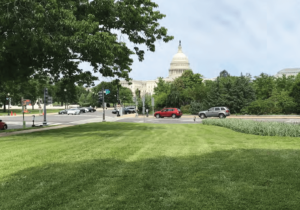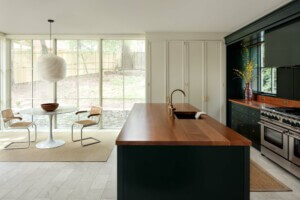Here we are in the year 2016, getting ready to ride in robot cars and eat meat grown in labs, but a skyscraper built out of wood still seems outlandish. Why? Wood is one of the world’s sturdiest and most versatile building materials. It has a single raw ingredient that doesn’t require intensive energy to produce: trees. The Horyuji temple precinct in Japan has wood structures that have been standing since about 700 AD. The onion-domed wooden churches on Russia’s Kizhi Island date to the early 18th century.
Today we have an innate distrust of tall wood buildings, a sense that they’ll roar into flame at the first spark. This distrust is, in part, a legacy of terrible 19th-century conflagrations like the Chicago Fire of 1871 and the Boston Fire of 1872. Those disasters and others led to the adoption of fire codes that prohibited wood structures above a certain height, saving lives in the process.
But it’s the 21st century, and a new exhibition at the National Building Museum in Washington challenges us to let go of our fear and embrace the future. The structural wood products that have recently entered the market are not your grandfather’s two-by-fours. Engineered timber beams have been proven in tests to be just as fireproof as steel, and arguably more so, since their cores as less likely to melt in a fire. They are also surprisingly strong.
In 2009, a nine-story apartment block in London was completed with an all-wood structure—load-bearing walls, floor slabs, elevator cores. Building with modern timber calls for a front-loaded process, which begins with sustainable forest management and expert milling (in close collaboration with the architect), and ends with a relatively quick assembly of prefabricated components. In other words, it changes how materials are sourced and how buildings are built. An overused cliché seems warranted here: Mass timber (the catch-all term for a host of different products) could disrupt the design and construction industries.
On display through May 21, 2017, Timber City occupies a single long room and part of the adjacent hallway on the second floor of Washington’s cavernous National Building Museum. Happily, wood is both the message and the medium in the exhibition design, by Yugon Kim and Tomomi Itakura of the Boston-based firm IKD. Information is presented on tall wooden boards propped against the walls. Large wood lozenges, stacked like pennies, hold the models. It’s a tactile and even olfactory show: Visitors can run a hand down a curved glu-lam beam, count the layers in a sandwich of cross-laminated timber (CLT), and compare laminated veneer to laminated strand lumber. Groups of tree stumps at either end of the room let you sit down for a moment to sniff the air (with so much wood, the room smells great).
Among the projects featured is a carousel pavilion in Stamford, Connecticut, that is just shy of completion, and a charter school in New Haven that opened a few months ago, both by Gray Organschi Architecture. The model of the carousel pavilion shows the undulations of precisely milled CLT in a cupola with three skylights, supported by a glu-lam rim beam. The UMass Design Building by Leers Weinzapfel Associates, now under construction in Amherst, Massachusetts, also makes extensive use of timber, including in its zipper-trussed atrium.
Those structures don’t exactly pierce the sky (the Design Building is four stories). But Framework, a project by Lever Architecture, will rise to 12 stories after it breaks ground next year in Portland, which will make it the tallest timber structure in the United States so far. Framework and another wood tower design by SHoP Architects, 475 West 18th (planned for a site on the High Line), won a prize from the U.S. Department of Agriculture, which is promoting tall timber—another sign this is not a passing fad.
For a small show, Timber City packs in a lot of information, and at times I wished it had more space to breathe. The Timber Over Time mural on one of the short walls is based on a clever conceit: It presents the history of wood construction through concentric tree rings. But as elsewhere, the text is small and dense. A board explaining the “forest-to-frame” life cycle is compelling—it really does seem to be a virtuous circle, with trees harvested at their carbon-storing peak, milled with little waste, and replaced by new growth—but I missed a more vivid sense of how trees become beams and boards. Too bad there wasn’t room to show footage from inside a factory or a time-lapse video of one of the buildings going up. (There is, however, a neat case of different wood byproducts that explains their uses.)
The exhibit is sponsored in part by the lumber industry, and it feels a bit like a sales pitch. But perhaps that’s necessary. The concrete and steel industries are huge; building codes are entrenched and slow to change (many of the early mass-timber buildings have gotten special code exemptions). Still an upstart, the timber camp may have to shout to make itself heard. Timber City proves that we all should be listening.
Timber City
National Building Museum, Washington, D.C., through May 21, 2017










